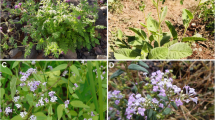Abstract
Larvicidal activity of three Eritrean medicinal plants was evaluated against Aedes aegypti by conducting the bioassay using WHO methods. Efficacy of the plant extracts of O. hadiense, R. officinalis and C. spinarum was evaluated against 3rd instar Aedes aegypti larvae and mortality was recorded. LC50 and LC90 of the various plant extracts were also calculated using probit analysis. The morphological analysis of treated larvae was also performed. Extracts of O. hadiense, C. spinarium and R. officinalis were prepared using different solvents viz chloroform, 70% ethanol and water. Of the screened extracts, the chloroform extracts of O. hadiense exhibited the highest larvicidal activities and has the minimum LC50 and LC90 (24 mg/ml and 198.411 mg/ml respectively). Chloroform extract of C. spinarium exhibited the least larvicidal activity with maximum LC50 and LC90 (736.883 mg/ml and 1188.699 mg/ml respectively). Microscopic analysis confirmed the changes in the Aedes aegypti larvae caused by various plants extracts. An accumulation of dark pigmentation was observed in abdominal region and in the anal papillae after contact and also showed major structural damage such as destruction of the gut.





Similar content being viewed by others
References
Ali S, Khan MR, Irfanullah M et al (2018) Phytochemical investigation and antimicrobial appraisal of Parrotiopsis jacquemontiana (Decne) Rehder. BMC Complement Altern Med. 18:43. https://doi.org/10.1186/s12906-018-2114-z
Ghosh A, Chowdhury N, Chandra G (2012) Plant extracts as potential mosquito larvicides. Indian J Med Res. 135(5): 581–598. PMID: 22771587; PMCID: PMC3401688
Govindarajan M, Mathivanan T, Elumalai K, Krishnappa K, Anandan A (2011) Ovicidal and repellentactivities of botanical extracts against Culex quinquefasciatus, Aedes aegypti and Anopheles stephensi (Diptera: Culicidae). Asian Pac J Trop Biomed. 1(1):43–48. https://doi.org/10.1016/S2221-1691(11)60066-X.PMID:23569723;PMCID:PMC3609154
Manzoor F, Samreen KB, Parveen Z (2013) Larvicidal activity of essential oils against Aedes aegypti and Culex quinquefasciatus larvae (Diptera: Culicidae). J Anim Plant Sci 23(2):420–424
Massebo F, Tadesse M, Bekele T, Balkew M, Gebre-Michael T (2009) Evaluation on larvicidal effects of essential oils of some local plants against Anopheles arabiensis Patton and Aedes aegypti Linnaeus (Diptera, Culicidae) in Ethiopia. Afr J Biotech 8(17):4183–4188
Mavundza EJ, Maharaj R, Chukwujekwu JC (2017) Screening for adulticidal activity against Anopheles arabiensis in ten plants used as mosquito repellent in South Africa. Malar J 13:173. https://doi.org/10.1186/1475-2875-13-173
Palanikumar M, Pravin Y, Navaneethan M, Mahendren S, Mohanraj RS, Dhanakkodi B (2017) Callistemon: citrus Myrtaceae methanolic leaf extract, a potent mosquitocidal agent for controlling dengue vector mosquito Aedes aegypti Diptera, culicidae. J Entomol Zool Stud 5(3):1051–1059
Rocha DK, Matos O, Novo MT, Figueiredo AC, Delgado M, Moiteiro C (2015) Larvicidal Activity against Aedes Aegypti of Foeniculum Vulgare Essential Oils from Portugal and Cape Verde. Nat Prod Commun. https://doi.org/10.1177/1934578X1501000438
Saranya M, Mohanraj R, Dhanakkodi B (2013) Larvicidal, pupicidal activities and morphological deformities of Spathodea campanulata aqueous leaf extract against the dengue vector Aedes aegypti. Eur J Exp Biol 3(2):205–213
World Health Organization. (2005). Guidelines for laboratory and field testing of mosquito larvicides (No. WHO/CDS/WHOPES/GCDPP/2005.13)
World Health Organization (2009) Dengue and severe dengue. https://www.who.int/news-room/fact-sheets/detail/dengue-and-severe-dengue- Accessed on 23.11.2023
Funding
The authors declare that no funds, grants, or other support were received during the preparation of this manuscript.
Author information
Authors and Affiliations
Contributions
All the authors contributed to the study conception and design. Work supervision, Material preparation, results analysis was performed by JJK, AK and DM. The laboratory work was done by RA, HK, KW, EB, EE. All authors read and approved the final manuscript.
Corresponding author
Ethics declarations
Conflict of interest
The authors have no relevant financial or non-financial interests to disclose.
Ethical approval
This is an in vitro biological screening. The college Research Ethics Committee has confirmed that no ethical approval is required.
Human participants and/or animals
No.
Informed consent
Not applicable.
Additional information
Publisher's Note
Springer Nature remains neutral with regard to jurisdictional claims in published maps and institutional affiliations.
Rights and permissions
Springer Nature or its licensor (e.g. a society or other partner) holds exclusive rights to this article under a publishing agreement with the author(s) or other rightsholder(s); author self-archiving of the accepted manuscript version of this article is solely governed by the terms of such publishing agreement and applicable law.
About this article
Cite this article
Kaushik, J.J., Kaushik, A., Mebrahtu, D. et al. Evaluation of larvicidal potential of Eritrean medicinal plants against Aedes aegypti. J Parasit Dis 48, 150–156 (2024). https://doi.org/10.1007/s12639-024-01653-7
Received:
Accepted:
Published:
Issue Date:
DOI: https://doi.org/10.1007/s12639-024-01653-7




